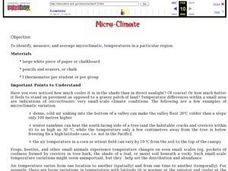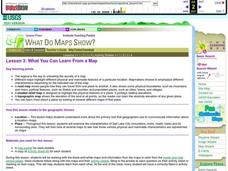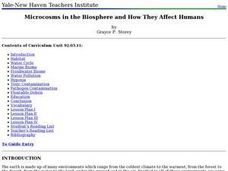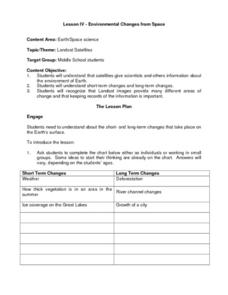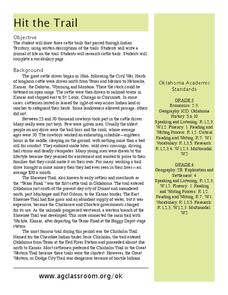Curated OER
Exploring the Hudson in 1609
While this lesson focuses on a study of the Hudson River, it could be used as a template for a discussion of map skills, converting measurements, and plotting a route. The lesson includes vocabulary and other resources to make it a...
Shmoop
ELA.CCSS.ELA-Literacy.L.9-10.1
If you're completely lost on what grammar you should cover for Common Core skill L.9-10.1, look here! You will find some ideas and examples on what to include, making sure your learners can master the skill. The multiple choice quiz is...
Curated OER
Micro-Climate
Atmosphere aces investigate the microclimates that exist within a larger area. They use a thermometer to record the varying temperatures and identify the microclimates on a map that they have drawn. This exercise helps them to understand...
Curated OER
Location
Students explore the tools used by Columbus to chart his latitude. They study the change of a location over time.
Curated OER
What You Can Learn From a Map
Pupils investigate the use of road maps, shadeded relief maps, and topographic maps.
Curated OER
A Fishy Tale
Eighth graders do a research project on a particular species of Atlantic seafood and record and graph information pertaining to commercial landings of that species of seafood. They use a website and an Appleworks spreadsheet.
Curated OER
Science: Microcosms in the Biosphere
In a series of lessons, examine the impact on humans by microcosms in the biosphere. Among the plans structured for learners with different abilities and learning styles, are activities describing the symbiotic relationship, drawing the...
Curated OER
Freedom Fighters Throughout American History
Students use the internet to research people who have contributed to the cause of freedom. They identify examples of freedom which are important to them and categorize them. In groups, they create a timeline of the Freedom Fighters and...
Curated OER
A Picture: Worth One Thousand Words?
Students examine photographs from the Civil War. Using a primary source document, they discover the conditions of a private during the Battle of Chickamauga. In groups, they use the sources to determine the authnecity of the documents.
Curated OER
Geography of China (Tibet)
Sixth graders study the geography of Tibet. They create maps of Tibet. Students predict population, land area, water area and coastline length of the United States and Tibet. Students compare and contrast the day-to-day lives of people...
Curated OER
The Floristic Relay: A Game to Teach Succession
Young scholars investigate the concept of succession and plant community dynamics. They play a game in order to conduct multiple experiments while playing. The interest of the game is useful for keeping student interest throughout the...
Curated OER
Grassland Animals
Third graders will be able to cut and paste from Internet into a word document with 100 percent accuracy. They use their research to write a 1-2 paragraph paper about their animal with 90 percent accuracy.
Curated OER
Word Formation Worksheet 7
In this ESL word formation worksheet, students read 7 sentences that have a missing word. Students fill the space using the base word given in bold at the end. Prefixes and suffixes may be added.
Curated OER
Bugs, Bugs, Everywhere!
Students collect and compare bugs using magnifying lenses and graph data based on their comparisons. In this bugs lesson plan, students also make an aspirator by using a jar, tubing, and screen.
Curated OER
The Wonderful World of Slugs
Examine a slug? Of course, what else would a 2nd grader do with it? Pupils use clues and go on a slug hunt, read a slug story, or make a cooperative group mural of a slug's habitat. While older learners catalog slugs, go on a slug hunt,...
Curated OER
Prairie Scavenger Hunt
Here is a simple lesson for young learners on the plants, animals, and flowers found in the prairie environment. There are worksheets embedded in the plan that pupils use once a teacher-led discussion and demonstration has taken place....
Curated OER
The American Revolution: A Play
No lesson accompanies this drama about the American Revolution. With 13 speaking roles, the short script could be used for a class production, a lesson on the parts of a play, or to supplement your social studies curriculum.
Curated OER
Step and Spell
Practice spelling words and reinforce the use of the QWERTY keyboard with this lesson. Learners create large alphabet cards and arrange them on the floor in the same way that the keyboard is set up. They step on letters to spell...
Curated OER
Environmental Changes from Space
Students discuss Landsat Satellites and the use of the images they provide as well as the purpose of keeping records of the information from the satellites. The class works in groups to complete a worksheet on short term and long term...
Curated OER
Hit the Trail
Students read about the history of cattle trails and complete language arts, math, social studies, and more activities about barbed wire. In this barbed wire lesson plan, students read poetry, research changes over time, draw cattle...
Curated OER
Marking Sentences
Test the identification skills of your class! Learners are required to mark 18 sentences for the prepositional phrases, infinitives, subjects, and verbs used in each. Some of the sentences are a little confusing with all of these parts...
Curated OER
Environmental Studies: The Environment Rocks!
Rock exploration, so exciting! After reading the book Everybody Needs a Rock, the class makes sandwiches to better understand that the Earth is made in layers. They then use a description of the 3 types of rock to conduct an observation...
Curated OER
Probability
Here is a classic activity used to introduce your class to the concept of probability and data collection. They will roll one die 30 times, then record and discuss the results. Great introduction, but too shallow to be considered a...
Curated OER
Mapping the New World Lesson Plan
Young scholars compare two maps of the same area from different time periods. In this American History lesson, students look at two maps of the English colonies from 1636 and 1651. They discuss why the maps changed and predict maps from...




